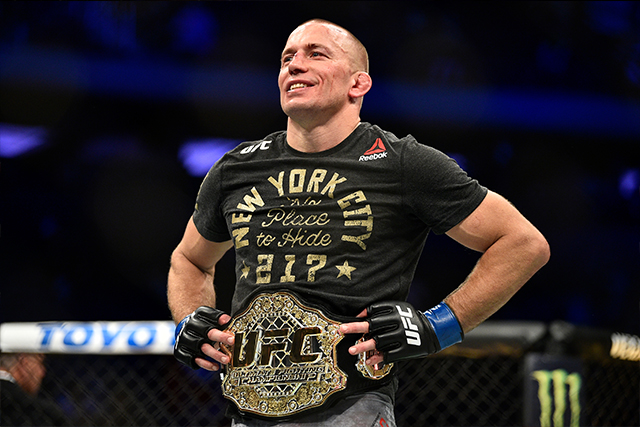UFC 119 Preview: The Main Card
Sherk vs. Dunham
Sep 22, 2010

Evan Dunham (top) file photo: Dave Mandel |
Sherdog.com
Sean Sherk vs. Evan Dunham
Advertisement
Already the owner of wins over Efrain Escudero and Tyson Griffin this year alone, Dunham is a problematic opponent in that he poses problems for both versions of Sherk. While most fighters will try to marry their best skills in a sort of fistic alchemy, Sherk has all but abandoned his smothering top-control game in favor of a striking style that emphasizes getting inside and hitting Gatling gun combinations. However, he doesn’t have the physical tools to make that approach work against anyone who won’t stay in the pocket with him.
Sherk has no reach. It’s when he’s getting hit from range and
whiffing on his own punches that he gets into trouble -- a scenario
that played out ad infinitum in bouts with B.J. Penn and
Frankie
Edgar. A bad trend for Sherk since Dunham not only has a
massive reach advantage on him, but unlike so many of his
contemporaries, he knows how to use his reach correctly. The jab
and left cross form the backbone of his striking, and that sort of
down-the-pipe punching style combined with Dunham’s reach will be
poisonous to Sherk.
Of course, should Sherk get inside on Dunham, he’ll have a marked hand speed advantage and few put together proper boxing combinations as well as he does. However, Sherk often struggles to get inside because his movement is so flatfooted. Compare that to Dunham, who moves in and out of range fluidly, which leads to his opponents coming up just short on their strikes.
Inconsistency is what to watch for from Dunham’s feet movement since it wasn’t until his match with Griffin that he showed the discipline to use it for a full 15 minutes. The other way to look at that is as evidence of Dunham’s ongoing improvement. While there have been some issues with Dunham’s conditioning and defense, both against takedowns and strikes, he has shown fight to fight improvement in those areas and further developed his offensive repertoire.
At 37 years of age with nearly 40 professional bouts to his name, Sherk is well past the point of making the kinds of quantum leaps that Dunham is becoming known for. The more worrying aspect for Sherk, though, is that he’s coming off a 15-month layoff marred by injury troubles. Cage rust, especially when caused by injuries, has been unkind to a great many returning fighter. There is no reason to believe Sherk will pull a Randy Couture and defy Father Time come Saturday night.
What many are expecting Sherk to do is revert back to his wrestling roots and grind out a vintage top control-fueled decision win. This blatantly ignores the fact that Sherk hasn’t relied on his wrestling to win a fight in more than three years. Also, we’re not jumping into a time machine and going back to 2004 for this fight. Sherk’s shot is undeniably explosive, but takedown defense at this level of MMA has improved dramatically in the years since he was double legging people through the canvas.
Chasing takedowns on Dunham is a dangerous game anyway since he’s unnaturally good at grabbing hold of the front headlock, where he can either threaten with chokes or step around into back control. If Sherk shoots in and doesn’t hit an instantaneous takedown, he’s going to find Dunham to be the vastly superior grappler in a scramble. Even if Sherk does get top control, Dunham is skilled at using the butterfly guard and deep half guard to disrupt his opponent’s base while shifting his own hips to escape to the feet or assume top control.
If there was some way of knowing that Sherk is absolutely injury free and prepared to use both his wrestling and striking in concert, this would be the most compelling fight on the card. As is, it’s a great bit of matchmaking that will almost certainly serve to further Dunham’s resume for title contention. Stopping Sherk is borderline impossible, but Dunham will beat him to the punch standing and get the better of him on the mat en route to a competitive but easy-to-score decision win.
Related Articles







